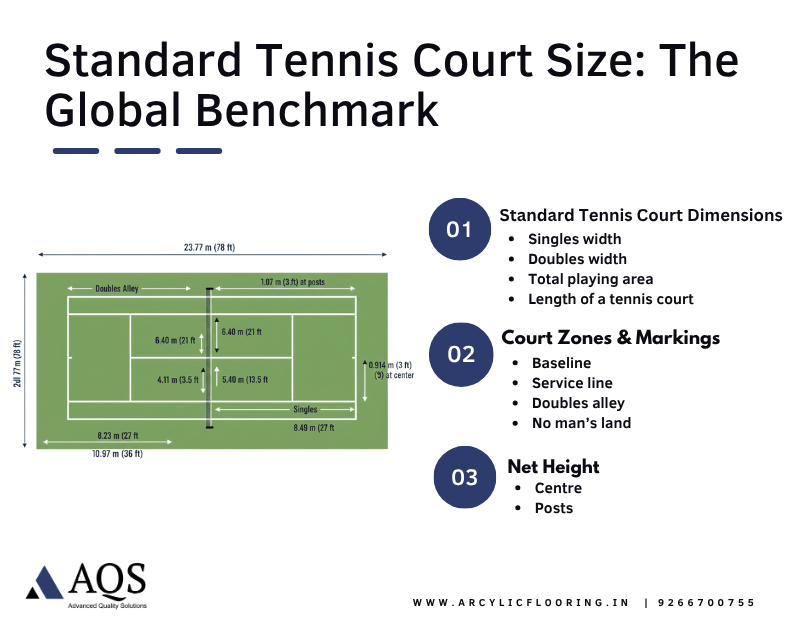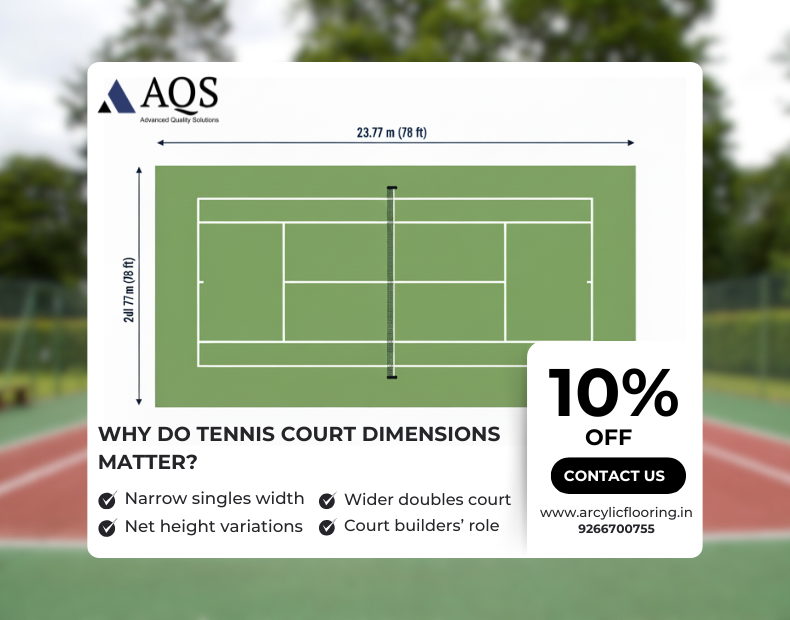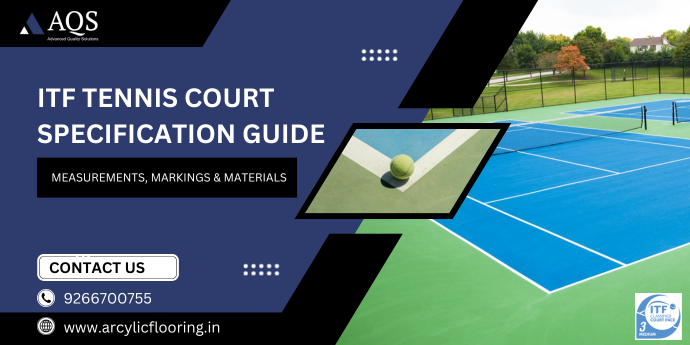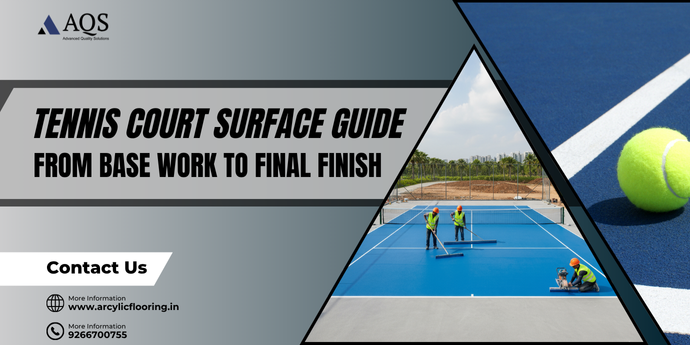Tennis has moved from being a niche recreational activity to a mainstream sport with schools, housing societies, clubs, academies and private residences across India. With this growth the demand for professionally built courts has increased and so has the need for clarity on tennis court size, tennis court measurements and overall tennis court dimension of lawn tennis.
A tennis court is not just a marked surface; every inch of its standard dimensions is designed to ensure fairness, safety and an enjoyable playing experience. From the length of a tennis court to the precise tennis court dimensions in feet and meters, accuracy is key to how players train and compete. Whether you are planning a backyard setup or a multi-court facility in a sports complex, understanding these details is the first step to building a world class infrastructure.
This blog will cover tennis court dimensions in feet and meters, standard layouts, construction materials, costs and practical insights for anyone building a new tennis court or resurfacing an existing one.
Standard Tennis Court Size: The Global Benchmark
When it comes to tennis court dimensions everything goes back to the International Tennis Federation (ITF). They are the ones who define the official global standards. These measurements make sure that every tennis court whether its a school, club or international arena has fair, balanced and uniform play conditions across all levels of the game.

Standard Tennis Court Dimensions
- Length of a tennis court:
This is the universal length for professional tennis courts flooring worldwide. It’s balanced for singles and doubles matches. Whether its a Grand Slam event or a recreational game in a housing society this measurement remains the same. - Singles width:
A singles tennis court is slightly narrower to test a player’s precision, endurance and shot accuracy. The smaller width boost games rallies, forcing players to focus on placement and stamina rather than power alone. - Doubles width:
Doubles matches need more lateral room for two players on each side. The wider tennis court encourages teamwork, coordination and creative shot angles adding an exciting dynamic that singles play doesn’t offer. - Total playing area:
This overall measurement includes the safety margins beyond the boundary lines, where players can move freely and chase wide shots without getting hurt. Its especially important for competitive matches and club installations where player safety and comfort matters.
Net Height
- Centre:
The middle of the net is slightly lower to encourage longer rallies and fairer play. It makes cross tennis court shots and serves more strategic and balanced shots. - Posts:
The net is higher at the posts to keep tension and stop sagging. This make sure a consistent bounce across the width of the tennis court, a key to professional play.
Court Zones & Markings
- Baseline:
This is the back line where players hit most of their groundstrokes. It defines offensive and defensive positioning and many modern players build their game around this zone. - Service line:
The service line divides the tennis court into boxes and defines where serves must land to be in. The uniform distance makes sure fairness and consistency in serving styles no matter where you play. - Doubles alley:
This narrow strip runs along the outside of the singles tennis court and only comes into play during doubles. It widens the playing area and creates new angles and shot variations that make doubles more planned and fun. - No man’s land:
Experienced players avoid this middle zone. Standing here can leave you vulnerable to deep or angled shots. It’s a strategic danger zone, important to understand for beginners and professionals developing positioning skills.
What are the Tennis Court Dimensions in Feet vs Meters?
For easy understanding, here is a comparison of tennis court dimensions in feet and meters:
| Court Element | Measurement in Feet | Measurement in Meters |
| Court Length | 78 ft | 23.77 m |
| Singles Court Width | 27 ft | 8.23 m |
| Doubles Court Width | 36 ft | 10.97 m |
| Net Height (Center) | 3 ft | 0.914 m |
| Net Height (Posts) | 3.5 ft | 1.07 m |
| Service Line Distance | 21 ft | 6.40 m |
These numbers shows the tennis court dimension of lawn tennis court, making sure global standardization.
Lawn Tennis Court Size: Outdoor vs Indoor
The lawn tennis court size is the same for both indoor and outdoor courts but the way courts are built varies based on the environment.
- Outdoor Courts: Outdoor tennis courts need super durable tennis court flooring that can withstand India’s harsh weather. From heating in summer to heavy rains and extended UV exposure, the flooring should ensure consistent bounce, grip and safety throughout the year.
- Indoor Courts: Indoor facilities have the same tennis court dimensions in feet and meters but the construction priorities change. Builders need to focus on controlled lighting to avoid glare, proper ventilation and acoustics and a ceiling clearance of at least 30 feet to accommodate lobs and competitive play.
- Material Choice: While the dimensions of tennis courts remain the same for indoor and outdoor courts, the material used is different. Acrylic and cushioned acrylic is used outdoors for durability and indoor courts may have specialized coatings or cushioning systems for comfort and year round performance.
Why Do Tennis Court Dimensions Matter?
- Narrow singles width means precision and baseline play:
In singles, the narrower tennis court requires accuracy in shot placement. Players rely on groundstrokes and baseline rallies, consistency and endurance. There’s less room for error, so precision is key. - Wider doubles court means teamwork and sharp angles:
The doubles alleys add width, more space for angled shots and net play. This layout demands communication, coordination and positioning between partners. Doubles court is all about covering space efficiently and creating sharper passing angles. - Net height variations add strategy to volleys and serves:
The net is higher at the posts and lower at the center, which affects serve trajectories and volley placement. Skilled players use the lower center for powerful flat serves and adjust shots to clear the higher sides. This adds another layer of strategy to both offence and defence. - Court builders need to understand these subtleties:
Professional tennis court builders need to take these dimensions into account when designing courts to make sure fair play. Correct measurements mean safe play, fair competition and ITF standards. A well designed court improves the game and player development.

Why AQS is the Best Choice?
When looking for a tennis court installation near me, choosing an experienced partner makes sure quality and durability. AQS is trusted across the nation for world-class courts because:
- ITF-Approved Tennis Court Materials: Every tennis court is built with internationally certified acrylic systems that meet ITF standards. These materials give consistent ball bounce, all-weather resistance and long lasting performance. By using tested and approved flooring, players and institutions can be sure of global quality play surfaces.
- Quality & Warranty: AQS backs its workmanship with warranty on flooring and coatings, so clients can have peace of mind. This means the tennis court is protected against premature wear and fading. It shows commitment to long term value and customer satisfaction.
- Wide Project Experience: With installations in housing societies, schools, sports academies and premium clubs, AQS has versatility. The company can design to suit recreational and professional needs. This extensive portfolio means expertise in handling different environments and challenges.
- Transparent Pricing: Clients get clear and competitive tennis court construction cost quotes without hidden charges. Every quote is detailed, including flooring, materials and accessories for complete transparency. This transparent approach helps clients plan their budget with confidence.
With a strong reputation, technical expertise and a nationwide dealer network, AQS makes tennis court installation reliable, professional and built to last.
Which Tennis Court is Suitable for Backyard & Compact Space?
- Mini Courts for Training & Fun: In small spaces, smaller courts with corresponding tennis court size can be built. These mini setups are constructed for homeowners, kids and communities to enjoy the sport in a scaled down version. They are a practical way to train and play without needing the full 120 × 60 ft footprint.
- Portable Nets & Modular Flooring: For quick and easy setups, portable net systems and modular tennis court surface solutions are important. They can be installed on existing concrete or open spaces, perfect for backyards, rooftops or temporary play areas. This reduces construction time and cost while still looking professional.
- Key Measurements for Practice: Even in mini courts, the tennis court measurements for baselines, service lines and net height are important. Keeping these dimensions makes sure best practice, good bounce and consistent play. This is for recreational players and young athletes to build skills in line with professional standards.
Choosing the Right Tennis Court Flooring
When choosing tennis court flooring consider the following:
- Climate: Acrylic flooring is designed to withstand extreme heat, heavy rainfall and UV exposure, perfect for Indian weather. Unlike clay or grass it doesn’t need frequent repairs.
- Budget: Compared to high maintenance clay or luxury grass courts, acrylic systems are cost effective and offer the best value. They provide professional level playing quality within the budget of schools, clubs or housing societies.
- Usage: For academies or high traffic facilities, cushioned acrylic flooring is preferred as it reduces impact on joints and muscles. This makes sure player comfort during long practice sessions and reduces the risk of injuries.
- Durability: A well-constructed synthetic acrylic tennis court can last 5-7 years with minimal maintenance. With timely tennis court resurfacing the tennis court will retain its bounce, grip and colors, giving long term returns on investment.
Conclusion
Building a tennis court is more than surface and marking boundaries. It requires a clear understanding of tennis court dimensions, planning of construction stages and selection of right materials that can withstand Indian climate. The lawn tennis court size may be the same worldwide, but the real difference lies in how well the court is built, maintained and customized to local requirements.
At AQS, we focus on more than just construction; for delivering international standard playing experience right here in India. With ITF approved materials, transparent pricing and proven expertise across schools, clubs, academies and housing societies, AQS makes sure that your tennis court is not only built to global standards but also customized to your needs.
Frequently Asked Questions
A tennis court is 78 ft (23.77 m) long and 36 ft (10.97 m) wide for doubles.
Yes, indoor and outdoor courts are the same size, only the flooring and lighting difference.
Acrylic synthetic flooring is ideal for Indian climate as it is durable, UV resistant and has smooth bounce.
Yes, mini or scaled down courts can be built using portable nets and modular acrylic flooring.
Cushioned acrylic systems provides shock absorption, consistent bounce and player comfort.
A good quality synthetic acrylic court lasts 5–7 years with proper maintenance and resurfacing.
Cost depends on surface material, cushion layers, base preparation and accessories used.




